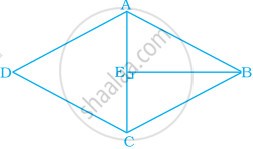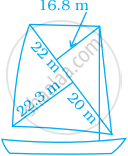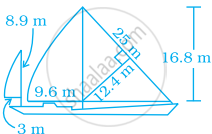Advertisements
Advertisements
प्रश्न
Find the missing value.
| Diagonal (d1) | Diagonal (d2) | Area |
| 26 m | 468 sq.m |
उत्तर
Given diagonal d1 = 26 m
Area of the rhombus = 468 sq.m
`1/2` (d1 × d2) = 468
`1/2` (26 × d2) = 468
(26 × d2) = 468 × 2
d2 = `(468 xx 2)/26`
d2 = 36 m
Tabulating the results we have
| Diagonal (d1) | Diagonal (d2) | Area |
| 26 m | 36 m | 468 sq.m |
APPEARS IN
संबंधित प्रश्न
If perimeter of a rhombus is 100 cm and length of one diagonal is 48 cm, what is the area of the quadrilateral?
If length of a diagonal of a rhombus is 30 cm and its area is 240 sq cm, find its perimeter.
The length of the diagonals of a rhombus is in ratio 4 : 3. If its area is 384 cm2, find its side.
Find the area of a rhombus whose base is 14 cm and height is 9 cm.
Find the missing value.
| Diagonal (d1) | Diagonal (d2) | Area |
| 12 mm | 180 sq.mm |
The area of the rhombus with side 4 cm and height 3 cm is
What is the area of the rhombus ABCD below if AC = 6 cm and BE = 4 cm?

Area of a quadrilateral ABCD is 20 cm2 and perpendiculars on BD from opposite vertices are 1 cm and 1.5 cm. The length of BD is ______.
Most of the sailboats have two sails, the jib and the mainsail. Assume that the sails are triangles. Find the total area sail of the sailboats to the nearest tenth.

Most of the sailboats have two sails, the jib and the mainsail. Assume that the sails are triangles. Find the total area of sail of the sailboats to the nearest tenth.

